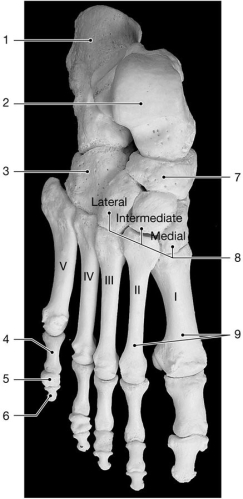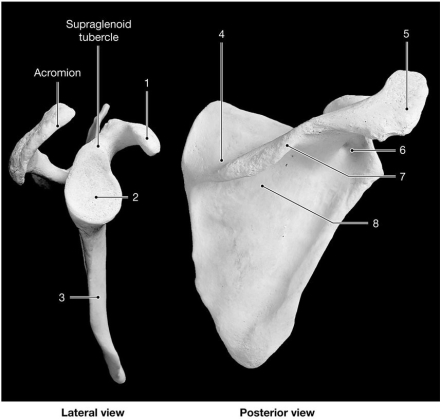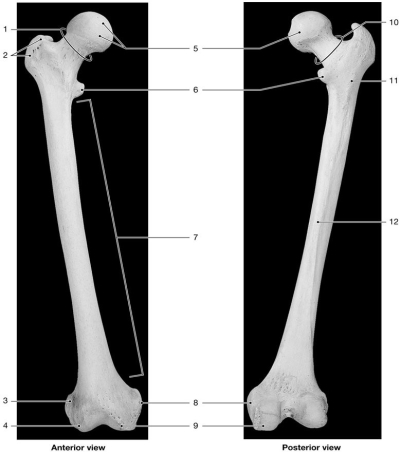A) rib pairs 1 and 2
B) manubria
C) coracoid processes
D) clavicles
E) acromial processes
G) C) and D)
Correct Answer

verified
Correct Answer
verified
Multiple Choice
 Figure 8-4 Bones of the Ankle and Foot
Use Figure 8-4 to answer the following questions:
-On which bone does the tibia press?
Figure 8-4 Bones of the Ankle and Foot
Use Figure 8-4 to answer the following questions:
-On which bone does the tibia press?
A) 1
B) 7
C) 9
D) 2
E) 3
G) None of the above
Correct Answer

verified
Correct Answer
verified
Multiple Choice
The hand has 15 phalangeal bones; the foot has 14 phalangeal bones.
A) The first statement is true but the second statement is false.
B) The first statement is false but the second statement is true.
C) The first statement is true and the second statement is true.
D) The first statement is false and the second statement is false.
E) There is too much anatomical variability to be sure.
G) A) and E)
Correct Answer

verified
Correct Answer
verified
Multiple Choice
Tina falls and fractures her pisiform bone.What part of her body was injured?
A) foot
B) forearm
C) wrist
D) hand
E) ankle
G) None of the above
Correct Answer

verified
Correct Answer
verified
Multiple Choice
When standing normally,most of your weight is transmitted to the ground by the
A) tibia,talus,and calcaneus.
B) talus and proximal metatarsals.
C) calcaneus and talus.
D) talus and cuneiforms.
E) calcaneus and proximal metatarsals.
G) D) and E)
Correct Answer

verified
Correct Answer
verified
Multiple Choice
 Figure 8-1 The Scapula
Use Figure 8-1 to answer the following questions:
-Identify the structure labeled "2."
Figure 8-1 The Scapula
Use Figure 8-1 to answer the following questions:
-Identify the structure labeled "2."
A) glenoid cavity
B) acetabulum
C) scapular cavity
D) scapular notch
E) rotator cup
G) D) and E)
Correct Answer

verified
Correct Answer
verified
Multiple Choice
On a field trip you discover a skeleton with the following characteristics: the acetabulum is directed laterally,the ischial spine points medially,and the angle inferior to the pubic symphysis is less than 90 degrees.The long bones of the arms and legs are relatively light and show epiphyseal plates.This skeleton is probably from
A) a young male.
B) a young female.
C) an elderly male.
D) an elderly female.
E) It is impossible to determine based on this information.
G) D) and E)
Correct Answer

verified
Correct Answer
verified
Multiple Choice
The bones that form the fingers are the
A) carpals.
B) tarsals.
C) metacarpals.
D) metatarsals.
E) phalanges.
G) B) and C)
Correct Answer

verified
Correct Answer
verified
Multiple Choice
Which of the following bones is not part of the appendicular skeleton?
A) scapula
B) tibia
C) sacrum
D) coxal bones
E) metacarpals
G) B) and D)
Correct Answer

verified
Correct Answer
verified
Multiple Choice
The clavicle articulates with the
A) coracoid process and the humerus.
B) glenoid cavity and scapular spine.
C) acromial and coracoid processes.
D) manubrium and xiphoid process.
E) acromial process and the manubrium.
G) B) and D)
Correct Answer

verified
Correct Answer
verified
Multiple Choice
The girdles of the appendicular skeleton support the bones of the
A) shoulder.
B) hip.
C) thoracic cage.
D) limbs.
E) vertebrae.
G) A) and D)
Correct Answer

verified
Correct Answer
verified
Multiple Choice
 Figure 8-3 The Femur
Use Figure 8-3 to answer the following questions:
-Identify the structure labeled "2."
Figure 8-3 The Femur
Use Figure 8-3 to answer the following questions:
-Identify the structure labeled "2."
A) greater trochanter
B) linea aspera
C) head
D) lateral epicondyle
E) lateral condyle
G) A) and B)
Correct Answer

verified
Correct Answer
verified
Multiple Choice
The only direct connection between the pectoral girdle and the axial skeleton is where the
A) clavicle articulates with the humerus.
B) clavicle articulates with the manubrium of the sternum.
C) coxal bones articulate with the femur.
D) vertebral column articulates with the sacrum.
E) clavicle articulates with the xiphoid process.
G) A) and C)
Correct Answer

verified
Correct Answer
verified
Multiple Choice
 Figure 8-1 The Scapula
Use Figure 8-1 to answer the following questions:
-Which structure is the acromion?
Figure 8-1 The Scapula
Use Figure 8-1 to answer the following questions:
-Which structure is the acromion?
A) 1
B) 2
C) 3
D) 4
E) 5
G) B) and D)
Correct Answer

verified
Correct Answer
verified
Multiple Choice
The part of the tibia that is easily felt through the skin and is known as the shin is the
A) medial malleolus.
B) anterior crest.
C) tibial tuberosity.
D) articular facet.
E) anterior margin.
G) C) and D)
Correct Answer

verified
Correct Answer
verified
Multiple Choice
Which of the following is/are not located outside the carpal tunnel?
A) median nerve
B) tendons
C) lunate bone
D) scaphoid bone
E) pisiform bone
G) All of the above
Correct Answer

verified
Correct Answer
verified
Multiple Choice
 Figure 8-3 The Femur
Use Figure 8-3 to answer the following questions:
-Identify the structure labeled "3."
Figure 8-3 The Femur
Use Figure 8-3 to answer the following questions:
-Identify the structure labeled "3."
A) greater trochanter
B) lesser trochanter
C) head
D) lateral epicondyle
E) lateral condyle
G) A) and C)
Correct Answer

verified
Correct Answer
verified
Multiple Choice
The bones that form the palm are the
A) carpals.
B) tarsals.
C) metacarpals.
D) metatarsals.
E) phalanges.
G) B) and D)
Correct Answer

verified
Correct Answer
verified
Multiple Choice
 Figure 8-3 The Femur
Use Figure 8-3 to answer the following questions:
-Identify the structure labeled "12."
Figure 8-3 The Femur
Use Figure 8-3 to answer the following questions:
-Identify the structure labeled "12."
A) greater trochanter
B) linea aspera
C) head
D) lateral epicondyle
E) lateral condyle
G) B) and D)
Correct Answer

verified
Correct Answer
verified
Multiple Choice
The talus contacts the
A) calcaneus.
B) navicular bone.
C) tibia.
D) calcaneus and navicular bones.
E) tibia,calcaneus,and navicular bones.
G) None of the above
Correct Answer

verified
Correct Answer
verified
Showing 41 - 60 of 115
Related Exams